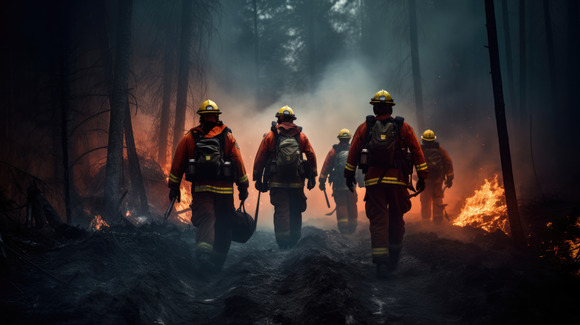-and-
As wildland fires increase in frequency and intensity, firefighters are experiencing more injuries and fatalities. Wildland firefighters work long shifts and are regularly exposed to heat, smoke, high altitude and other hazards.
Source: US Department of Agriculture
By Sara Delheimer, Multistate Research Fund Impacts Program
Photo: Courtesy Adobe Stock
Wildland fires result in massive losses of life and property each year. As wildland fires increase in frequency and intensity, firefighters are experiencing more injuries and fatalities.
Wildland firefighters work long shifts that require hiking, digging trenches, felling trees, operating machinery, carrying heavy packs and other arduous tasks. They are regularly exposed to heat, smoke, humidity, high altitude, toxic plants, rough terrain and other hazards.
Firefighters rely on personal protective equipment (PPE) to keep them safe from these hazards, but many have expressed issues with improper fit, reduced mobility, low durability, chafing and overheating.
Researchers at Land-grant Universities are working together to help wildland firefighters perform their tasks effectively and safely.

Research Highlights (2019-2024)
Project members assessed available wildland firefighter PPE and user needs.
- Iowa State University researchers analyzed firefighter gloves.
- Researchers at Louisiana State University assessed PPE size charts.
- University of Idaho researchers collaborated with an Extension specialist and dietitian to study the nutrient needs of wildland firefighters and ways to improve PPE so that firefighters can carry snacks with them while on fire lines.
- In 2023, researchers from Florida State University and North Carolina State University published a scholarly journal article about female firefighters’ increased risk of occupational exposure due to ill-fitting PPE.
- Researchers at multiple universities developed a survey to identify wildland firefighters’ PPE needs and conducted focus groups and interviews to collect data on design, comfort, fit and other performance issues.
Scientists evaluated new textiles and designs for wildland firefighter PPE.
- To enhance wildland firefighter safety and performance, researchers investigated the feasibility of incorporating wearable technology, such as monitors for heart rate, skin temperature and carbon monoxide exposure and GPS trackers, into PPE.
- Researchers created gear that fits better and has improved functionality for women firefighters.
Researchers evaluated how use and care, such as laundering, affects the performance, durability and longevity of wildland firefighter PPE.
- Wildland firefighters are required to wear protective clothing that meets standards for flame resistance, tensile strength, thermal protection and more. But certification is based on new gear. Researchers are evaluating the useful life of PPE after exposure to real world use. In particular, researchers are looking at abrasion resistance, shrinkage, elongation, strength and other factors after laundering.
- Wildland firefighters can only pack a limited amount of PPE when deployed, so clothing is used repeatedly before changing or cleaning. Researchers explored issues, such as skin chafing, that repeated wear over long shifts may cause.
- Researchers developed a survey to investigate when, where and how wildland firefighters clean and maintain their PPE. The team distributed the survey to wildland firefighters across the U.S. In 2024, researchers published the first study on wildland firefighting PPE cleaning practices in the U.S. Findings will inform educational materials and recommended best practices.
Project members established new guidelines, standards and educational materials for wildland firefighter PPE.
- Researchers provided critical input on cleaning practices for the revised NFPA 1877 Standard on Selection, Care and Maintenance of Wildland Firefighting Protective Clothing and Equipment.
- Project members developed educational materials and training modules to educate wildland firefighters and other stakeholders on the selection, proper use and maintenance of PPE.





